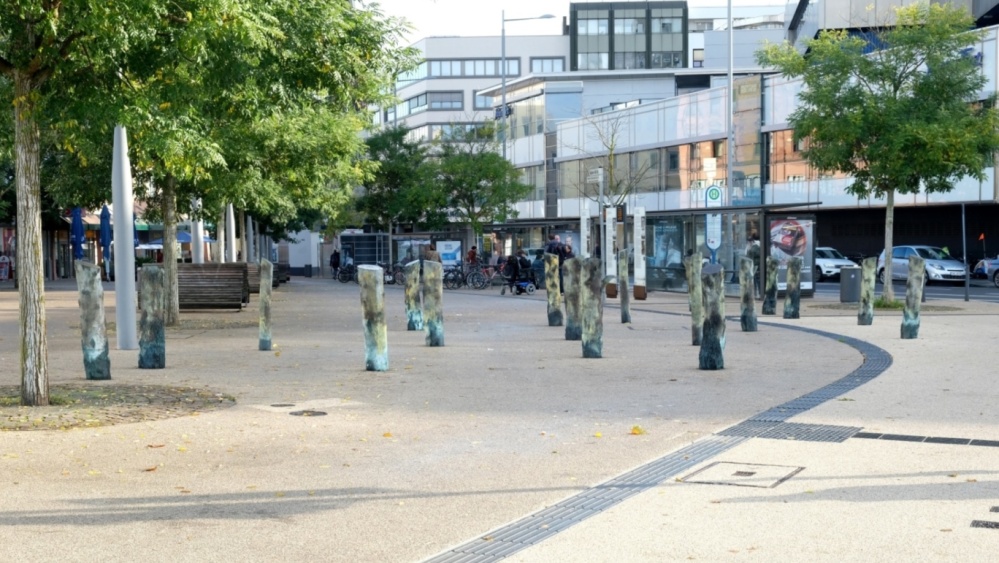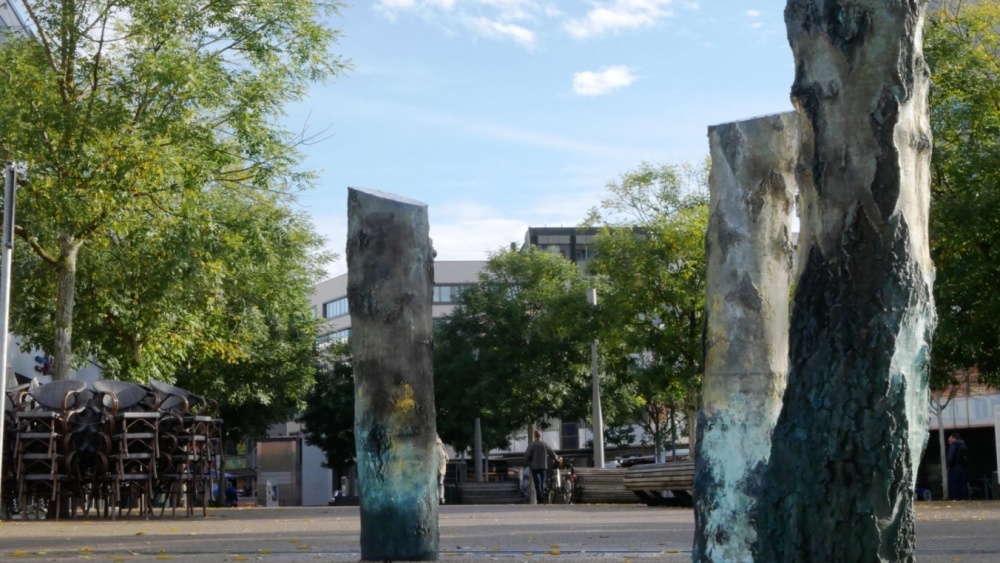Rabbi Rülf Plaza and “The interrupted forest” sculpture
“THE INTERRUPTED FOREST” PLACE OF REMEMBRANCE
“The interrupted forest” is a memorial to the Jews from the Saar Region murdered under the Nazi regime. It is based on a concept by Darmstadt sculptor Prof. Ariel Auslender. His was the winning design in an artist’s competition organised by the Saarland capital in 2012.
Composed of 40 bronze, 1.10-metre-high tree trunks, the sculpture is randomly grouped across the plaza and the top part of the open flight of steps leading to the Berliner Promenade. The sculptural group of tree stumps creates an image of memory, of loss and brutally truncated tradition. It stands in contrast to the graceful Japanese pagoda trees, thus accentuating the disparity between the “natural forest” on the one hand and the stylised forest of remembrance on the other.
Plebiscite of 1935 and annexation of the Saar to the Third Reich
JEWISH LIFE IN THE SAAR AND SAARBRÜCKEN
Following the First World War, the Saar Territory was separated from the German Reich and, under the provisions of the Treaty of Versailles, placed under the administration of the League of Nations. 15 years later, in 1935, a plebiscite was held to decide whether the Saar should retain this status, be reunited with Germany or be annexed by France.
After Hitler’s rise to power in 1933, anti-Semitism became increasingly prevalent in Nazi-controlled Germany. This caused many Jews to flee the Reich and seek shelter in the Saar Region. Daily, new refugees swelled the ranks of Saarbrücken’s Jewish community. Dr Rülf, Saarbrücken’s rabbi at the time, recognised the impending threat.
In Saarbrücken’s schools, Jewish children were abused and physically attacked by fellow pupils. So in 1933 the Jewish community demanded a school of their own.
It was largely through the intervention of Rülf and his network that under the provisions of the Rome Agreement international Jewish organisations obtained a guarantee declaration from Nazi Germany that, up until 29 February 1936, no persons who had resided in the Saar Region on 3 December 1934, irrespective of their nationality, would be discriminated against on the grounds of their language, race or religion.
This effectively exempted the Saarland from anti-Jewish legislation for a period of one year if it were to rejoin the German Reich. In the plebiscite of 13 January 1935, over 90 percent of the people of the Saar Region voted for annexation of the Saar to the Third Reich. In the wake of this outcome, more and more Jewish families emigrated abroad. The Rome Agreement helped many of the Saar Region’s Jews to escape the Nazi regime. No one could know they were fated to fall victim to the Nazi genocide just a few years later.
On the night of 9-10 November 1938, the Saarland’s synagogues were also desecrated, destroyed and set ablaze – including the synagogue in Saarbrücken, on the corner of Futterstraße/Kaiserstraße. Jewish men and women were dragged from their homes, badly beaten and abused. By 1939, almost 90 percent of the Saar Region’s Jews had left.
According to the census held on 17 May 1939, only 177 Jews remained in Saarbrücken. On 22 October 1940, the Saar Region’s remaining Jews, together with the Jews from Baden and the Saar-Palatinate, were deported by rail in sealed cattle cars to Gurs in southern France. From there, the majority were sent to the death camps at Auschwitz and Theresienstadt, where they were murdered in cold blood.
RABBI DR FRIEDRICH SCHLOMO RÜLF
Dr Friedrich Schlomo Rülf was rabbi of the Jewish community in Saarbrücken from autumn 1929 to early January 1935. During the First World War he served as a rabbi in the field on the western front. Recognising the dimension of the National Socialist threat early on, he quickly fought to protect the Jewish community. He was principally responsible for the founding of the private Jewish primary school in Saarbrücken.
Within the Jewish community he set up a five-member “committee” that worked undercover. Rülf and his network were instrumental in orchestrating the Rome Agreement. Rülf’s decision to emigrate to Palestine, already on the cards before he took up his post in Saarbrücken, was in the meantime irreversible and he left Saarbrücken on 10 January 1935. Following the Saar Plebiscite of 13 January 1935, Rülf worked intensively to guarantee that the Rome Agreement was implemented.
In Palestine, he adopted his second name, Schlomo. He worked from October 1935 until autumn 1937 at the agricultural school in Mikve Israel, and then until 1958 devoted himself to developing the school system in the settlement of Nahariya (Israel) founded by German Jewish immigrants.
His ties to the Saarland were never completely broken. In 1951, he returned to Saarbrücken for a year as rabbi and helped to rehabilitate the Saar Jewish community newly established in the summer. He died in Vevey (Switzerland) in 1976 while travelling through Europe.



